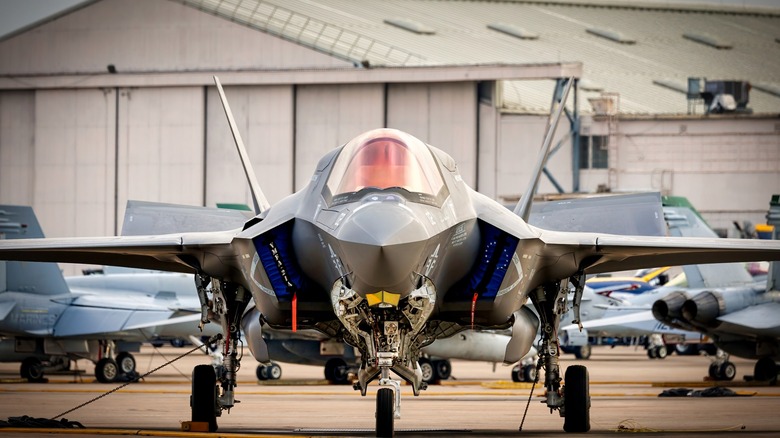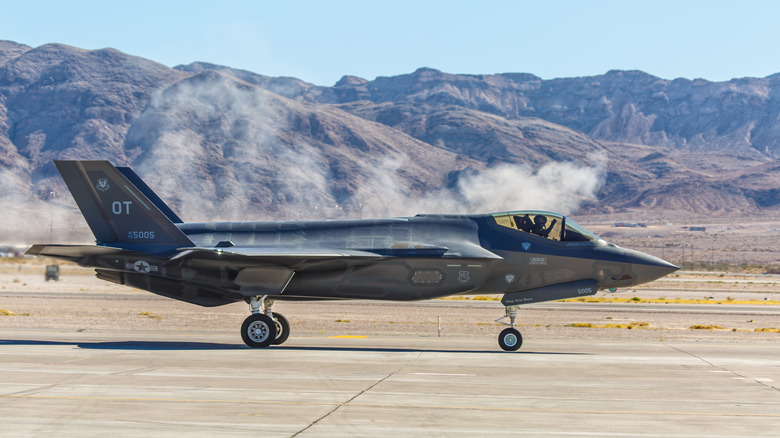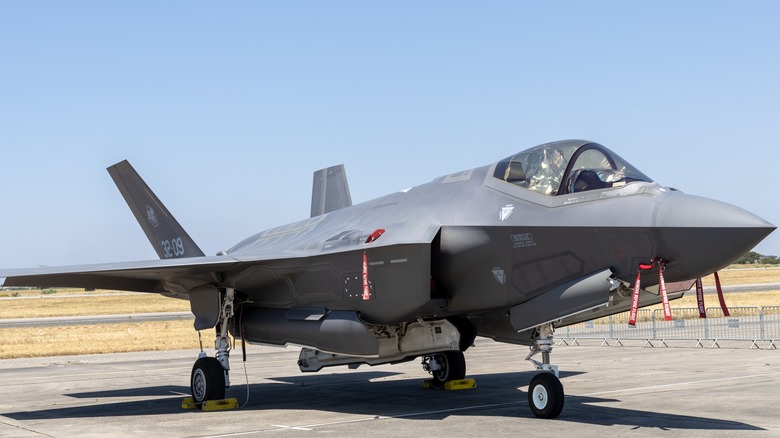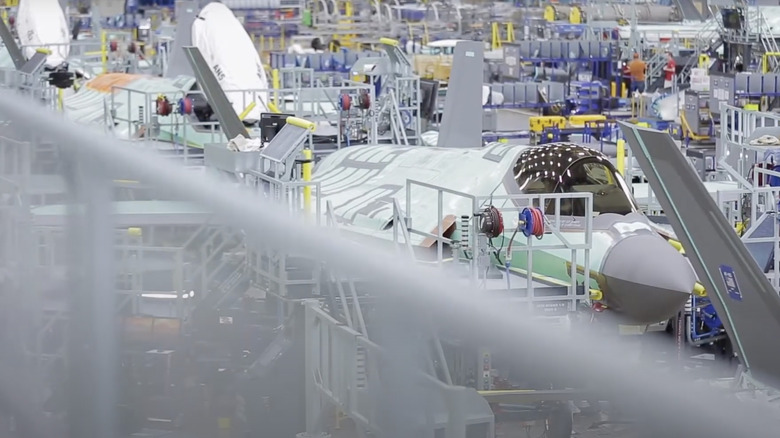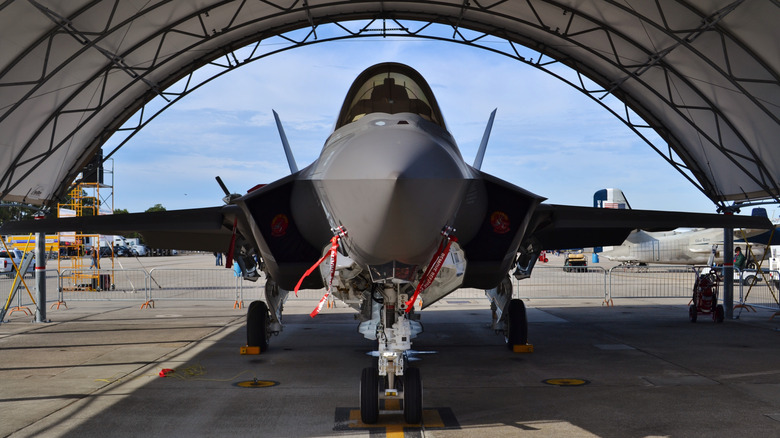Where Is The F-35 Lightning II Built And Who Makes Them?
Since it was launched in 2006, the F-35 has made a name for itself as playing a key role in global deterrence. Designed for use by the United States and its various allies in NATO, the F-35 is a product of the Joint Strike Fighter program, which had the goal of strengthening member air force units while reducing overall production costs. As of October 2024, the F-35 Lightning II program has delivered over a thousand units, logged in almost a million flight hours, and trained over 2,000 pilots worldwide. So far, 19 countries are part of its program, which include the United States, the United Kingdom, Israel, Greece, Japan, and Singapore.
While the verdict is still out there if the F-35 really is the most advanced jet fighter in the world, there's one thing we know for sure: It's a force to be reckoned with in the skies. With stealth capabilities that can evade radar and advanced sensors, the multi-role fighter jet is a notable addition to any military unit. In the past, we've done a deep dive into the different F-35 jet variants, including the F-35A, which is used by the Air Force, and the F-35B, which was designed for battles at sea and has impressive vertical landing capabilities. Not to mention, there's also the F-35C that plays a key role in the Navy's carrier requirements. But, who are the brains behind the F-35 Lightning II, and where are the planes manufactured today?
Who makes the F-35 Lightning II?
With decades of aviation history, it's unsurprising that Lockheed Martin was the contractor of choice to produce the F-35 Lightning II. To be able to provide the necessary capabilities, it works with over 1,600 suppliers globally to bring the F-35 to life. Known for producing some iconic jets through the years, Lockheed Martin loaded the F-35 Lightning II with everything from laser-guided bombs to network-centric systems. In recent times, the renowned arms manufacturer hasn't slowed down with its upgrades to the F-35 and even revealed its first air-launched hypersonic missile earlier this year.
Other contractors working on the F-35 also deserve some praise, such as Elbit Systems and Rockwell Collins, who developed the remarkable F-35 Helmet Mounted Display System (HMD). The F-35 HMD, which costs a whopping $400,000 each, is known to clock in immersive tracking and improved situational awareness. As of 2024, the 1,000th F-35 pilots have been outfitted with the highly personalized HMD.
Not to mention, the F-35's powerful engine, the F135, is made by Pratt & Whitney. Gracing all the F-35 variants, Pratt & Whitney claims that the 5th generation engine is 15 times safer than its predecessor, significantly better at thermal management, and has over 40,000+ lbs of thrust. Apart from the F-35, Pratt & Whitney has also produced some other ground-breaking engines, such as the Wasp, an engineering landmark in its own right. In addition, they also make the F117-PW-100 engine that powers the colossal C-17 Globemaster III.
The companies behind the F-35's electronics and communications systems
Another crucial contractor on the F-35 development team includes BAE Systems, which led the development of crucial life-saving designs, like crew escape and life support. Renowned for its Short Take Off and Vertical Landing (STOVL) technology, BAE Systems also produces the aft fuselage, horizontal tail, and vertical tail. And, of course, part of what makes the F-35 such a compelling jet fighter isn't just the ballistics but also its advanced communication systems, navigation, and networking.
BAE Systems also provided electronic systems for the F-35 Lightning II, such as warfare suits and vehicle management. In the past, we've also talked about how the British firm was working on innovating active camouflage technology and how it was awarded by the United States Army to develop next-generation missile warning systems (MWS).
Northrop Grumman also played a huge role in developing mission systems, as well as mission-planning software. The American defense manufacturer produces the F-35's anti-radiation guided missiles, the center fuselage, the Active Electronically Scanned Array (AESA) Radars, and other sensors.
Where is the F-35 Lightning II built?
Initially, the F-35 was built primarily at Lockheed Martin Fort Worth Air Force Plant 4 manufacturing facility in Fort Worth, Texas. With a long history of producing aircraft, the Fort Worth plant was also where several notable bombers, like B-24 Liberators, B-36 Peacemakers, and B-58 Hustlers, were made. In more recent times, the facility was also home to the iconic F-16 fighter jet.
However, global defense needs have led to the expansion of F-35 production facilities to meet ongoing demand in recent times. In March 2015, the Italian Air Force announced the completion of the first F-35 Lightning II made on European soil. In partnership with Alenia Aermacchi, the Cameri Final Assembly and Check Out (FACO) facility was the first non-US production facility for the F-35 fighter jets. Additionally, it was established as the primary European facility for maintenance in the region.
Two years later, the Japanese Air Self-Defense Force unveiled the first F-35A, which was also built domestically at the Mitsubishi Heavy Industries (MHI) Final Assembly and Check Out (FACO) in 2017. By 2024, the Nagoya plant had produced six F-35 jets already, with plans to add more in the future, according to AP News.
In this day and age, you'll be hard-pressed to find any type of technology that is completely made in one place. After all, global supply chains have made it possible to optimize the production process. Given this, you may be wondering why it matters where the F-35 is made.
Why it matters where the F-35 Lightning II is made
As with all types of vehicles that can affect national security, there are a couple of key reasons why it matters where fighter jets like the F-35 Lightning II are made. Similar to why India was so keen to develop its first domestic aircraft, the HAL Tejas, countries stand to benefit from being able to reduce ongoing dependence on other nations because of the various security risks that come with them. In fact, production of the F-35 was infamously delayed due to risks associated with parts of Chinese origin, according to Politico.
Aside from the benefits of employing and upskilling local talent, it helps protect countries from being left behind in terms of knowledge of the latest technology. Not to mention, by having more control over the supply chain, countries will be able to prioritize their own defense needs instead of being at the mercy of production timelines set by foreign contractors, which can be delayed due to a variety of reasons.
Lastly, with locally-made fighter jets, American military units can experience a variety of logistic benefits. Aside from reduced delivery costs, there's also better access to the parts and talent that can assist with any issues that may arise (or even just routine maintenance). That said, one key reason why the F-35 remains controversial is the massive delays in delivery, which even led to the United States Department of Defense withholding payments earlier this year.
